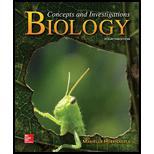
Concept explainers
A DNA molecule is placed in a test tube containing fluorescently tagged
a. only one DNA molecule would have two fluorescent strands.
b. both strands of each DNA molecule would be half-fluorescent.
c. each DNA molecule would have one fluorescent strand.
cl. both DNA molecules would be completely fluorescent.
Introduction:
DNA replication is a process of producing two identical copies of DNA from parental DNA. DNA replication is known as semicoservative, because each new copy will have one parental strand.
Answer to Problem 1MCQ
Correct answer:
Each DNA molecule would have one florescent strand. This statement explains correctly that DNA replication is a semi conservative process. Therefore, option c. is correct
Explanation of Solution
Reason for the correct statement:
DNA replication is a semi conservative process in which new replicas of DNA will have one parental strand. So, in this DNA molecule one strand will be normal and other strand will be florescent.
Option c. is given as “each DNA molecule would have one florescent strand”.
As, “DNA replication is a semi conservative process so whenever a new replica is formed it will always have one parental strand, so in this DNA molecule one strand will be normal and other strand will be florescent”, is the right answer.
Hence, option c. is correct.
Reasons for the incorrect statements:
Option a. is given as “only one DNA molecule would have two florescent strands”.
This is never possible in case of replication because if replication occurs then parental strand is shared within the replicas, so both florescent strands cannot stick together. So, it is a wrong answer.
Option b. is given as “both strands of each DNA molecule would be half florescent”.
This is the case of dispersive replication, but in case of DNA it only replicate through semicoservative way. So, it is a wrong answer.
Option d. is given as “both DNA molecules would be completely florescent”
This is the case of conservative replication, but in case of DNA it only replicate through semi-conservative way. So, it is a wrong answer.
Hence, options a., b., and d. are incorrect.
DNA replicates through semi-conservative way in which new replica is formed and that new replica will always have one parental strand.
Want to see more full solutions like this?
Chapter 8 Solutions
Biology: Concepts and Investigations
Additional Science Textbook Solutions
Human Physiology: An Integrated Approach (8th Edition)
Chemistry & Chemical Reactivity
Applications and Investigations in Earth Science (9th Edition)
Genetics: From Genes to Genomes
Campbell Essential Biology (7th Edition)
- Amino Acid Coclow TABle 3' Gly Phe Leu (G) (F) (L) 3- Val (V) Arg (R) Ser (S) Ala (A) Lys (K) CAG G Glu Asp (E) (D) Ser (S) CCCAGUCAGUCAGUCAG 0204 C U A G C Asn (N) G 4 A AGU C GU (5) AC C UGA A G5 C CUGACUGACUGACUGAC Thr (T) Met (M) lle £€ (1) U 4 G Tyr Σε (Y) U Cys (C) C A G Trp (W) 3' U C A Leu בוט His Pro (P) ££ (H) Gin (Q) Arg 흐름 (R) (L) Start Stop 8. Transcription and Translation Practice: (Video 10-1 and 10-2) A. Below is the sense strand of a DNA gene. Using the sense strand, create the antisense DNA strand and label the 5' and 3' ends. B. Use the antisense strand that you create in part A as a template to create the mRNA transcript of the gene and label the 5' and 3' ends. C. Translate the mRNA you produced in part B into the polypeptide sequence making sure to follow all the rules of translation. 5'-AGCATGACTAATAGTTGTTGAGCTGTC-3' (sense strand) 4arrow_forwardWhat is the structure and function of Eukaryotic cells, including their organelles? How are Eukaryotic cells different than Prokaryotic cells, in terms of evolution which form of the cell might have came first? How do Eukaryotic cells become malignant (cancerous)?arrow_forwardWhat are the roles of DNA and proteins inside of the cell? What are the building blocks or molecular components of the DNA and proteins? How are proteins produced within the cell? What connection is there between DNA, proteins, and the cell cycle? What is the relationship between DNA, proteins, and Cancer?arrow_forward
- please fill in the empty sports, thank you!arrow_forwardIn one paragraph show how atoms and they're structure are related to the structure of dna and proteins. Talk about what atoms are. what they're made of, why chemical bonding is important to DNA?arrow_forwardWhat are the structure and properties of atoms and chemical bonds (especially how they relate to DNA and proteins).arrow_forward
- The Sentinel Cell: Nature’s Answer to Cancer?arrow_forwardMolecular Biology Question You are working to characterize a novel protein in mice. Analysis shows that high levels of the primary transcript that codes for this protein are found in tissue from the brain, muscle, liver, and pancreas. However, an antibody that recognizes the C-terminal portion of the protein indicates that the protein is present in brain, muscle, and liver, but not in the pancreas. What is the most likely explanation for this result?arrow_forwardMolecular Biology Explain/discuss how “slow stop” and “quick/fast stop” mutants wereused to identify different protein involved in DNA replication in E. coli.arrow_forward
- Essentials of Pharmacology for Health ProfessionsNursingISBN:9781305441620Author:WOODROWPublisher:Cengage
 Human Heredity: Principles and Issues (MindTap Co...BiologyISBN:9781305251052Author:Michael CummingsPublisher:Cengage Learning
Human Heredity: Principles and Issues (MindTap Co...BiologyISBN:9781305251052Author:Michael CummingsPublisher:Cengage Learning
 Concepts of BiologyBiologyISBN:9781938168116Author:Samantha Fowler, Rebecca Roush, James WisePublisher:OpenStax College
Concepts of BiologyBiologyISBN:9781938168116Author:Samantha Fowler, Rebecca Roush, James WisePublisher:OpenStax College Human Biology (MindTap Course List)BiologyISBN:9781305112100Author:Cecie Starr, Beverly McMillanPublisher:Cengage Learning
Human Biology (MindTap Course List)BiologyISBN:9781305112100Author:Cecie Starr, Beverly McMillanPublisher:Cengage Learning Biology Today and Tomorrow without Physiology (Mi...BiologyISBN:9781305117396Author:Cecie Starr, Christine Evers, Lisa StarrPublisher:Cengage Learning
Biology Today and Tomorrow without Physiology (Mi...BiologyISBN:9781305117396Author:Cecie Starr, Christine Evers, Lisa StarrPublisher:Cengage Learning





